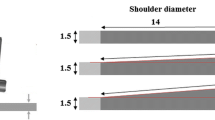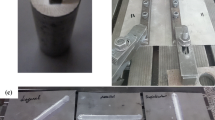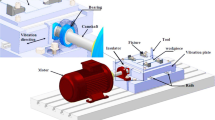Abstract
In this work, studies on formability of Tailor Welded Blanks (TWB) were carried out by means of both quasi-static and high speed forming process. TWBs were manufactured as welded blanks of dissimilar material combination. Welding of AA 5052-H32 to AA 6061-T6 aluminium alloy of 1 mm thickness was done with the help a friction stir welding (FSW) process. Limit dome height (LDH) test was performed by both conventional hydraulic press forming (HPF) and by a high-speed forming process called electromagnetic forming (EMF) process, to investigate the forming behaviour of the TWB. Subsequently forming limit curves (FLCs) were plotted to quantify forming behaviour. Dome heights and FLCs of TWB and base materials are compared. Similar comparison has been made between conventional forming and EM forming process. It is found that the formability of TWB increases considerably with EMF process with base AA 5052 material showed largest increase in formability. Effect of weld line offset on the formability was also investigated. When the weld line was offset by 25 mm towards AA 6061 side of the TWB, the welded blanks showed maximum forming behaviour by EMF process in terms of both dome height and FLC.
Similar content being viewed by others
References
Thomas WM, Nicholas ED, Needham JC, Murch MG, Templesmith P, Dawes CJ (1991) Patent Application No 9125978.8
Mishra RS, Ma ZY (2005) Friction stir welding and processing. J Mats Sci Eng R (50):1−78
Dawes CJ, Thomas WM (1996) Friction stir process welds aluminium alloys. Weld J 75(3):41–45
Picu RC, Vincze G (2005) Strain rate sensitivity of the commercial aluminum alloy AA5182-O. Mater Sci Eng 390:334–343
Miles MP, Decker BJ, Nelson TW (2004) Formability and strength of friction-stir-welded aluminum sheets. Metall Mater Trans 35:3461–3468
Shigematsu I, Kwon YJ, Suzuki K, Imai T, Saito N (2003) Joining of 5083 and 6061 aluminium alloys by friction stir welding. J Mater Sci Lett 22(5):353–356
Giera A, Merklein M, Geiger M (2005) Statistical investigations on friction stir welded aluminum tailored blanks for a robust process window. Adv Mater Res (6-8):599-606
Hong ST, Kwon YJ, Son HJ (2008) The mechanical properties of friction stir welding (FSW) joints of dissimilar aluminum alloys. Proc. 1st Int Symp. on Hybrid materials and processing, Busan, pp 69
Leitao C, Leal RM, Rodrigues DM, Loureiro A, Vilaça P (2009) Tensile behaviour of similar and dissimilar AA5182-H111 and AA6016-T4 thin friction stir welds. Mater Des 30:101–108
Park SK, Hong ST, Park JH, Park KY, Kwon YJ, Son HJ (2010) Effect of material locations on properties of friction stir welding joints of dissimilar aluminium alloys. Sci Technol Weld Join 15:331–336
RajKumar V, VenkateshKannan M, Sadeesh P, Arivazhagan N, Devendranath RK (2014) Studies on effect of tool design and welding parameters on the friction stir welding of dissimilar aluminium alloys AA 5052 – AA 6061. Procedia Eng 75:93–97
Scialpi A, De Giorgi M, Filippis LAC, Nobile R, Panella FW (2008) Mechanical analysis of ultra-thin friction stir welding joined sheets with dissimilar and similar materials. Mater Des 29(5):928–936
Leal RM, Leitão C, Loureiro A, Rodrigues DM, Vilac P (2008) Material flow in heterogeneous friction stir welding of thin aluminium sheets: effect of shoulder geometry. Mater Sci Eng 498:384–391
Rodrigues DM, Loureiro A, Leitao C, Leal RM, Chaparro BM, Vilaça P (2009) Influence of friction stir welding parameters on the microstructural and mechanical properties of AA 6016-T4 thin welds. Mater Des 30:1913–1921
Psyk V, Risch V, Kinsey BL, Tekkaya AE, Kleiner M (2011) Electromagnetic forming—a review. J Mater Process Technol 211:787–829
Wagner HJ, Boulger FW (1960) High velocity metalworking processes based on the sudden release of electrical of electrical energy. Memorandum prepared by the Battle Memorial Institute for the Defense Metals Information Center
Yudaev VD (1989) Manufacture of large sheet-metal parts by incremental electromagnetic forming. Kuznechno-Shtampovochnoe Proizvodstvo - Forging Stamping Ind J 7:1–2
Balanethiram VS, Daehn GS (1994) Hyperplasticity: increased forming limits at high workpiece velocity. Scr Metall Mater 30:515–520
Vohnout VS (1998) A Hybrid Quasi-Static/Dynamic Process for Forming Large Sheet Metal Parts from Aluminum Alloys. Ph.D. thesis, The Ohio State University
Oliveira DA, Worswick MJ, Finn M (2001) Simulation of electromagnetic forming of aluminum alloy sheet. SAE paper 2001-01-0824. SAE Trans 110(5):687–695
Oliveira DA, Worswick MJ (2003) Electromagnetic forming of aluminum alloy sheet. J Phys IV 110:293–298. doi:10.1051/jp4:20030709
Noh HG, Song WJ, Kang BS, Kim J (2015) Two-step electromagnetic forming process using spiral forming coils to deform sheet metal in a middle-block die. Int J Adv Manuf Technol 76:1691
Li F, Mo J, Li J, Zhao J (2016) Formability evaluation for low conductive sheet metal by novel specimen design in electromagnetic forming. Int J Adv Manuf Technol. doi:10.1007/s00170-016-8893-9
Cui X, Li J, Mo J, Fang J, Zhou B, Xiao X (2016) Effect of the sheet thickness and current damping exponent on the optimum current frequency in electromagnetic forming. Int J Adv Manuf Technol 85:843–851
Maxwell JC (1873) A treatise of electricity and magnetism. Macmillan and Co. Publishers to the University of Oxford
ASTM International (2008) Standard test method for determining forming limit curves. ASTM E2218:1–15
Doley JK, Kore Sachin D (2016) A study on friction stir welding of dissimilar thin sheets of aluminum alloys AA 5052–AA 6061. J Manuf Sci Eng (ASME) 138/114502:1–6
Author information
Authors and Affiliations
Corresponding author
Rights and permissions
About this article
Cite this article
Doley, J.K., Kore, S.D. Comparison of electromagnetic forming of friction stir-welded blanks of dissimilar material AA 5052-AA 6061 with conventional forming process. Int J Adv Manuf Technol 93, 3789–3797 (2017). https://doi.org/10.1007/s00170-017-0793-0
Received:
Accepted:
Published:
Issue Date:
DOI: https://doi.org/10.1007/s00170-017-0793-0




